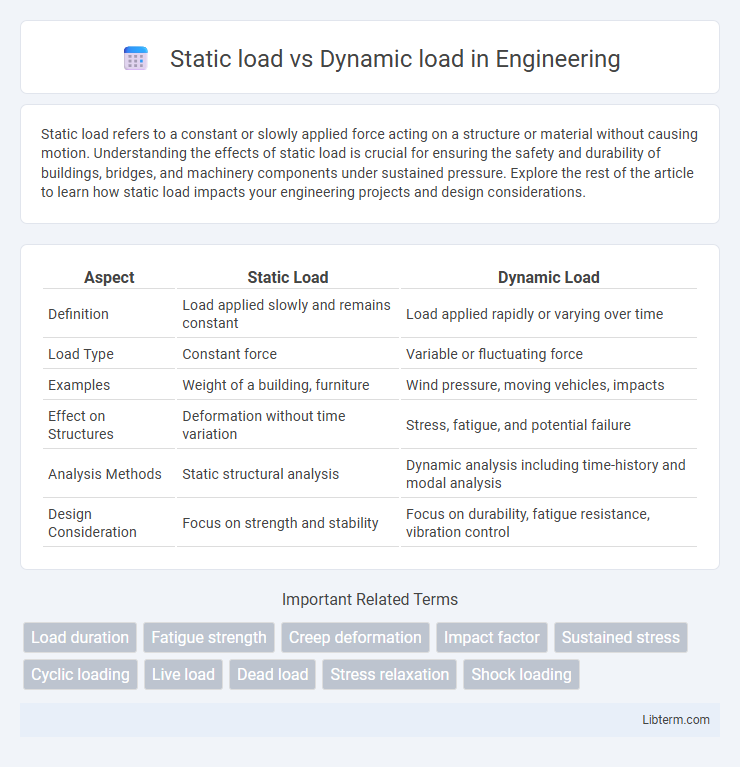Static load refers to a constant or slowly applied force acting on a structure or material without causing motion. Understanding the effects of static load is crucial for ensuring the safety and durability of buildings, bridges, and machinery components under sustained pressure. Explore the rest of the article to learn how static load impacts your engineering projects and design considerations.
Table of Comparison
| Aspect | Static Load | Dynamic Load |
|---|---|---|
| Definition | Load applied slowly and remains constant | Load applied rapidly or varying over time |
| Load Type | Constant force | Variable or fluctuating force |
| Examples | Weight of a building, furniture | Wind pressure, moving vehicles, impacts |
| Effect on Structures | Deformation without time variation | Stress, fatigue, and potential failure |
| Analysis Methods | Static structural analysis | Dynamic analysis including time-history and modal analysis |
| Design Consideration | Focus on strength and stability | Focus on durability, fatigue resistance, vibration control |
Introduction to Static and Dynamic Loads
Static loads refer to forces applied slowly and steadily on a structure, remaining constant or changing very gradually over time, such as the weight of a building or furniture. Dynamic loads involve forces that vary rapidly with time, including impact, vibrations, and moving loads like vehicles or machinery. Understanding the distinction between static and dynamic loads is crucial for structural engineering to ensure safety, stability, and durability under various loading conditions.
Key Definitions: Static Load vs Dynamic Load
Static load refers to a constant or slowly varying force applied to a structure or object, remaining steady over time without causing acceleration. Dynamic load involves forces that change rapidly with time, often causing acceleration and resulting in vibrations, impacts, or oscillations. Understanding the distinction between static and dynamic loads is critical for engineering design, ensuring structures can withstand both constant stresses and transient forces effectively.
Types of Static Loads
Static loads consist of two primary types: dead loads, which are permanent forces such as the weight of the structure itself including beams, floors, and walls, and live loads, which are transient forces like occupants, furniture, and movable equipment that vary over time but remain relatively constant during application. These loads are crucial for structural analysis as they help determine stress distribution and deformation under steady conditions without acceleration. Understanding static load types enables engineers to design safe and durable buildings that withstand consistent forces throughout their lifespan.
Types of Dynamic Loads
Dynamic loads include impact loads, vibration loads, and cyclic loads, each causing varying types of stress and strain on structures. Impact loads result from sudden forces such as collisions or explosions, vibration loads stem from repetitive oscillations like machinery or wind, and cyclic loads involve repeated loading and unloading sequences typical in bridges and aircraft. Understanding these dynamic load types is crucial for designing structures to withstand fluctuating forces and prevent fatigue failure.
Fundamental Differences Between Static and Dynamic Loads
Static loads remain constant over time and do not change or move, typically including weights such as stationary structures or furniture. Dynamic loads vary with time and involve forces that cause motion or impact, such as wind, traffic, or machinery vibrations. The fundamental difference between static and dynamic loads lies in how the forces are applied and the resultant structural response, with dynamic loads requiring consideration of inertial effects and time-dependent variations.
Applications in Engineering and Construction
Static loads in engineering and construction refer to forces that remain constant or change very slowly, such as the weight of a building, furniture, or permanent fixtures, ensuring structural stability under sustained pressure. Dynamic loads involve rapidly changing forces like wind, earthquakes, vibrations from machinery, or moving vehicles, requiring materials and designs capable of absorbing and dissipating energy to prevent failure. Understanding the distinction and impact of static versus dynamic loads is critical for selecting appropriate materials, designing foundations, and ensuring safety and durability in structures like bridges, skyscrapers, and industrial facilities.
Effects of Static and Dynamic Loads on Structures
Static loads produce constant or slowly varying forces that cause structural elements to experience steady stress and strain, potentially leading to deformation or permanent set over time. Dynamic loads generate rapidly changing forces, inducing vibrations and cyclic stresses that can result in fatigue, resonance, and eventual structural failure if not properly addressed. Understanding the distinct effects of static and dynamic loads is critical for designing structures to withstand both sustained and fluctuating forces for safety and durability.
Load Calculation Methods and Standards
Static load calculation methods involve analyzing forces that remain constant or change slowly over time, typically using standards like ASCE 7 and Eurocode for structural design. Dynamic load calculations account for time-varying forces such as wind, seismic activity, or machinery vibrations, employing specialized standards including ISO 5348 and the American Society of Civil Engineers (ASCE) guidelines for earthquake-resistant structures. Accurate load assessment requires integrating both static and dynamic factors to ensure compliance with international building codes and optimize structural safety and performance.
Advantages and Disadvantages of Each Load Type
Static loads provide predictable force applications, enabling straightforward structural analysis and design, which enhances safety and durability. However, they do not account for fluctuating forces, potentially overlooking stress variations under real-world conditions. Dynamic loads simulate actual operational environments with time-varying forces, improving design accuracy for fatigue resistance but require complex modeling and higher computational resources.
Conclusion: Choosing the Right Load Analysis
Selecting the appropriate load analysis depends on the nature of the forces acting on the structure; static load analysis suits scenarios with constant or slowly applied forces, ensuring stability under steady conditions. Dynamic load analysis is essential when dealing with variable or impact forces, such as vibrations, earthquakes, or moving loads, to accurately predict structural responses. Accurate load selection optimizes safety, performance, and cost-effectiveness in engineering design.
Static load Infographic

 libterm.com
libterm.com